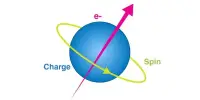A lab focusing on neuromorphic computing or brain-inspired computing has published new research that introduces hardware improvements by leveraging a quality known as ‘randomness’ or ‘stochasticity.’ Their research refutes the perception of randomness as a quality that will have a negative impact on computation results and demonstrates the use of finely controlled stochastic features in semiconductor devices to improve performance optimization. This has the potential to create a more sophisticated building block for creating computers capable of tackling complex optimization problems, potentially making them more efficient. Furthermore, they can use less power.
While the public often associates AI with software, researchers in Han Wang’s Emerging Nanoscale Materials and Device Lab at the USC Ming Hsieh Department of Electrical and Computer Engineering and the Mork Family Department of Chemical concentrate on improving AI and machine learning performance through hardware. The lab, which focuses on neuromorphic computing or brain-inspired computing, has recently published new research that introduces hardware improvements by leveraging a quality known as “randomness” or “stochasticity.”
Their research, which has been published in Nature Communications, refutes the perception of randomness as a quality that will have a negative impact on computation results and demonstrates the use of finely controlled stochastic features in semiconductor devices to improve performing optimization.
Neurons exhibit stochastic behavior, which can aid in certain computational functions. This method emulates the stochastic properties of neuron activity. By reconfigurable tuning of the device’s intrinsic stochastic property, the hetero-memristors they developed introduce such probability-governed randomness into a neuromorphic computing circuit.
Xiaodong Yan
Randomness is important in human thought or computation in the brain. It is formed by billions of neurons that fire in response to input stimuli, generating a plethora of signals that may or may not be relevant. The decision-making process is perhaps the most well-studied example of how our brain uses randomness. It enables the brain to deviate from previous experiences and explore a new solution when making a decision, particularly in a difficult and unpredictable situation.
“Neurons exhibit stochastic behavior, which can aid in certain computational functions,” said Jiahui Ma, a USC PhD student, and lead author Xiaodong Yan (both equally contributed as first authors). The team wanted to mimic neurons as much as possible, so they created a circuit to solve combinatorial optimization problems, which are among the most important tasks for computers to complete.
The theory is that in order for computers to do this efficiently, they must behave more like the human brain (on steroids) in terms of how they process stimuli and information, as well as how they make decisions.

In a nutshell, we need computers to find the best solution out of all possible solutions. “The randomness introduced in the new device demonstrated in this work can prevent it from becoming stuck at a not-so-viable solution, and instead continue to search until it finds a close-to-optimal result,” researchers write. According to corresponding author Professor Wang, “if one can dynamically tune the randomness features, the machine for performing optimization can work more efficiently as we desire.”
The researchers accomplish this dynamic “tuning” by developing a specialized device known as a hetero-memristor. In contrast to transistors, which are logic switches inside a standard computer chip, the hetero-memristor combines memory and computation. Memristors have previously been developed, typically with a two-terminal structure. The Viterbi team’s innovation is in adding a third electrical terminal and modulating its voltage to activate the neuron-like device and dynamically tune the stochastic features in its output, similar to how one heats up a pot of water and dynamically adjusts the temperature to control the activity of the water molecules, thus enabling simulated “cooling.” This provides a level of control that previous memristors did not.
“This method emulates the stochastic properties of neuron activity,” the researchers write. In reality, neuron activity appears to be random, but it may follow a specific probability pattern. By reconfigurable tuning of the device’s intrinsic stochastic property, the hetero-memristors they developed introduce such probability-governed randomness into a neuromorphic computing circuit.
As a result, this is a more sophisticated building block for creating computers that can tackle complex optimization problems, potentially making them more efficient. Furthermore, they can use less power.
This design philosophy not only preserves the benefits of existing general-purpose computers but also employs a brain-inspired chip to improve the ability to process unstructured data. Simultaneously, we will follow the technical path of computer science and neuroscience fusion, making full use of the characteristics of emerging non-volatile storage devices (including memristors), developing new computing models and algorithms suitable for these devices, and building a completely new type of intelligent computing system.
















